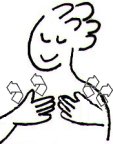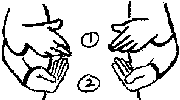American Sign Language for the Deaf Lesson 9: “I am… “
By Elaine Ernst Schneider
 |
 |
 |
 |
 |
 |
 |
 |
 |
 |
 |
 |
| Sign | Description of Action |
| am, be, is (ASL) | Using the right “d” hand, touch under the chin and then move forward and outward. |
| am (SE) | Touch “a” hand to chin and then straight forward, keeping the tilt of the hand sideways, palm facing to the left. |
| alone | Make a right “d” hand and turn the back of the hand outward. Make one circular rotation, right, forward, left, and then back to the starting position. |
| excited | Using both middle fingers, touch the chest alternately in a forward and upward motion, as if “stirring up” emotions. |
| fine | Touch the thumb of the open right hand (fingers spread) to the center of the chest area. |
| happy | Touch chest with closed fingers of both hands in a forward circular motion, as if “stirring” emotions of joy. |
| I (ASL) | Point to self, mid chest. |
| I (SE) | Touch the “i” hand to the center of the chest. |
| sad | Spread fingers and place hands several inches in front of the face, palms in . Move hands in a downward position to indicate a flow of tears. |
| sick | Middle fingers, both hands, point to head (right) and chest (left) at the same time. |
| smart | Touch a right “d” hand to the forehead; then move the “d” hand outward with a “saluting” motion. The wrist will rotate so that when the sign is finished, the palm faces outward. |
| tired | Place fingertips of bent “c” hands on upper chest. Move hands in a downward motion, pivoting the hands so that each finger touches the chest as the hands rotate into the final position where fingertips point upward, no longer touching the body. |
| wonderful | Hold open hands, palms facing outward, near the sides of the face. Move hands up and forward several times. Note: Some signers use spread fingers; others close the fingers. Either is acceptable. |
Continue to Lesson 10: “I can drive to…” click here
More Articles by this author, Click Here
More Articles in this Subject, Click Here
